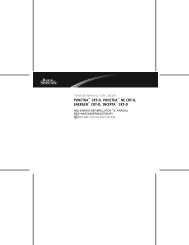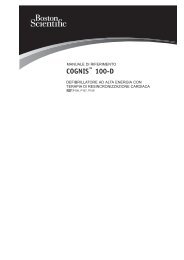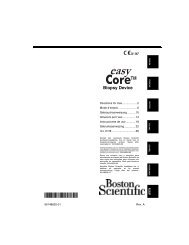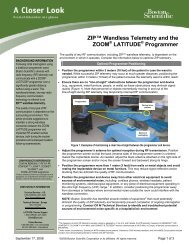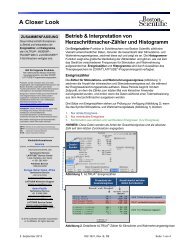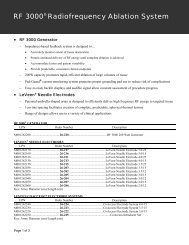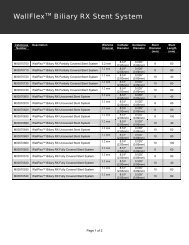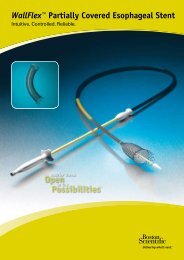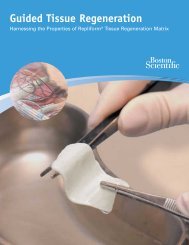External Printer Options for the ZOOM LATITUDE ... - Boston Scientific
External Printer Options for the ZOOM LATITUDE ... - Boston Scientific
External Printer Options for the ZOOM LATITUDE ... - Boston Scientific
Create successful ePaper yourself
Turn your PDF publications into a flip-book with our unique Google optimized e-Paper software.
CRT-P System from <strong>Boston</strong> <strong>Scientific</strong> – Contak Renewal ® TR<br />
Indications<br />
The CONTAK RENEWAL TR pulse generator is indicated <strong>for</strong> patients who have moderate to severe heart failure (NYHA Class III/IV) including left ventricular dysfunction (EF ≤ 35%) and QRS duration ≥<br />
120 ms and remain symptomatic despite stable, optimal heart failure drug <strong>the</strong>rapy (as defined in <strong>the</strong> clinical trials section in <strong>the</strong> System Guide). These devices provide atrial-ventricular tracking modes to<br />
help preserve AV synchrony and adaptive-rate pacing <strong>for</strong> patients who would benefit from adjusted pacing rates concurrent with physical activity.<br />
Contraindications<br />
These devices are contraindicated in patients who have a separate implanted cardioverter-defibrillator (ICD). Single-chamber atrial pacing is contraindicated in patients with impaired AV nodal conduction.<br />
Atrial tracking modes are contraindicated <strong>for</strong> patients with chronic refractory atrial tachyarrhythmias (atrial fibrillation or flutter), which might trigger ventricular pacing. Asynchronous pacing is<br />
contraindicated in <strong>the</strong> presence (or likelihood) of competition between paced and intrinsic rhythms.<br />
Warnings<br />
Read <strong>the</strong> product labeling thoroughly be<strong>for</strong>e implanting <strong>the</strong> pulse generator to avoid damage to <strong>the</strong> system. For single patient use only Do not reuse, reprocess, or resterilize. Such damage can result in<br />
patient injury or death. Do not expose a patient to MRI device scanning. Do not expose a patient with an activated implanted pulse generator to dia<strong>the</strong>rmy. Do not use atrial-only modes in patients with<br />
heart failure. The clinical outcomes <strong>for</strong> patients with chronic refractory atrial tachyarrhythmias are not fully known. Safety and effectiveness studies have not been conducted. If a chronic refractory atrial<br />
tachyarrhythmia develops in a patient with <strong>the</strong>se devices, do not use dualchamber or single-chamber atrial pacing. Left ventricular (LV) lead dislodgment to a position near <strong>the</strong> atria can result in atrial<br />
oversensing and LV pacing inhibition.<br />
Precautions<br />
For specific in<strong>for</strong>mation on precautions, refer to <strong>the</strong> following sections of <strong>the</strong> product labeling: clinical considerations; sterilization, storage and handling; implantation and device programming; pulse<br />
generator explant and disposal; environmental and medical <strong>the</strong>rapy hazards. Advise patients to avoid sources of electromagnetic interference (EMI) because EMI may cause <strong>the</strong> pulse generator to deliver<br />
inappropriate <strong>the</strong>rapy or inhibit appropriate <strong>the</strong>rapy.<br />
Potential Adverse Events<br />
Potential adverse events include, but are not limited to, <strong>the</strong> following: allergic/physical/physiologic reaction, death, erosion/migration, fibrillation or o<strong>the</strong>r arrhythmias, lead or accessory breakage<br />
(fracture/insulation/lead tip), hematoma/seroma, inappropriate or inability to provide <strong>the</strong>rapy (pacing/sensing), infection, lead tip de<strong>for</strong>mation and/or breakage, procedure related, and component failure. In<br />
rare cases severe complications or device failures can occur.<br />
Refer to <strong>the</strong> product labeling <strong>for</strong> specific indications, contraindications, warnings/ precautions and adverse events. Rx only.<br />
(Rev. M)<br />
CRT-P Systems from <strong>Boston</strong> <strong>Scientific</strong> - INVIVE TM<br />
Indications<br />
The Invive cardiac resynchronization <strong>the</strong>rapy pacemaker (CRT-Ps) is indicated <strong>for</strong> patients who have moderate to severe heart failure (NYHA Class III/IV) including left ventricular dysfunction (EF ≤ 35%)<br />
and QRS duration ≥ 120 ms and remain symptomatic despite stable, optimal pharmacologic <strong>the</strong>rapy <strong>for</strong> heart failure. Atrial tracking modes are also indicated <strong>for</strong> patients who may benefit from<br />
maintenance of AV synchrony. Adaptive-rate pacing is indicated <strong>for</strong> patients exhibiting chronotropic incompetence and who would benefit from increased pacing rates concurrent with increases in physical<br />
activity.<br />
Contraindications<br />
These devices are contraindicated in patients who have a separate implanted cardioverter-defibrillator (ICD). Single-chamber atrial pacing is contraindicated in patients with impaired AV nodal conduction.<br />
Atrial tracking modes are contraindicated <strong>for</strong> patients with chronic refractory atrial tachyarrhythmias (atrial fibrillation or flutter), which might trigger ventricular pacing. Asynchronous pacing is<br />
contraindicated in <strong>the</strong> presence (or likelihood) of competition between paced and intrinsic rhythms.<br />
Warnings<br />
Read <strong>the</strong> product labeling thoroughly be<strong>for</strong>e implanting <strong>the</strong> pulse generator to avoid damage to <strong>the</strong> system. For single use only. Do not reuse, reprocess or resterilize. Always have external defibrillation<br />
protection available during implant and electrophysiologic testing. Do not use this pulse generator with ano<strong>the</strong>r pulse generator. In response to applicable nonrecoverable or repeat fault conditions, <strong>the</strong><br />
pulse generator will switch irreversible to Safety Core operation. Do not kink, twist, or braid leads. Do not use atrial tracking modes in patients with chronic refractory atrial tachyarrhythmias. Do not use<br />
atrial only modes in patients with heart failure. In devices with <strong>the</strong> lead safety switch programmed to On, <strong>the</strong> lead polarity will switch to unipolar in <strong>the</strong> presence of a lead impedance of ≤ 200 or ≥ 2000 Ω. If<br />
programmed to a fixed atrial sensitivity value of 0.15 mV, <strong>the</strong> pulse generator may be more susceptible to electromagnetic interference. Advise patients to seek medical guidance be<strong>for</strong>e entering<br />
environments that could adversely affect <strong>the</strong> operation of <strong>the</strong> active implantable medical device. Do not expose a patient to MRI scanning. Do not subject a patient with an implanted pulse generator<br />
and/or lead to dia<strong>the</strong>rmy. Left ventricular (LV) lead dislodgment to a position near <strong>the</strong> atria can result in atrial oversensing and LV pacing inhibition.<br />
Precautions<br />
For specific in<strong>for</strong>mation on precautions, refer to <strong>the</strong> following sections of <strong>the</strong> product labeling: clinical considerations; sterilization and storage; implantation; device programming; environmental and<br />
medical <strong>the</strong>rapy hazards; hospital and medical environments ; home and occupational environments; follow up testing; explant and disposal; and supplemental precautionary in<strong>for</strong>mation. Advise patients<br />
to avoid sources of electric or magnetic interference (EMI) because EMI may cause <strong>the</strong> pulse generator to deliver inappropriate <strong>the</strong>rapy or inhibit appropriate <strong>the</strong>rapy.<br />
Potential Adverse Events<br />
Potential adverse events include, but are not limited to, <strong>the</strong> following: allergic/physical/physiologic reaction, death, erosion/migration, fibrillation or o<strong>the</strong>r arrhythmias, lead or accessory breakage<br />
(fracture/insulation/lead tip), hematoma/seroma, inappropriate or inability to provide <strong>the</strong>rapy (pacing/sensing), infection, lead tip de<strong>for</strong>mation and/or breakage, procedure related, and component failure. In<br />
rare cases severe complications or device failures can occur.<br />
Refer to <strong>the</strong> product labeling <strong>for</strong> specific indications, contraindications, warnings/ precautions and adverse events. Rx only.<br />
(Rev. A)<br />
ICD Systems from <strong>Boston</strong> <strong>Scientific</strong> – PUNCTUA, ENERGEN, and INCEPTA<br />
ICD Indications and Usage<br />
PUNCTUA TM , ENERGEN TM , and INCEPTA TM ICDs are intended to provide ventricular antitachycardia pacing and ventricular defibrillation <strong>for</strong> automated treatment of life-threatening ventricular<br />
arrhythmias.<br />
Contraindications<br />
Use of <strong>the</strong>se ICD systems are contraindicated in: Patients whose ventricular tachyarrhythmias may have reversible cause, such as 1) digitalis intoxication, 2) electrolyte imbalance, 3) hypoxia, or 4)<br />
sepsis, or whose ventricular tachyarrhythmias have a transient cause, such as 1) acute myocardial infarction, 2) electrocution, or 3) drowning. Patients who have a unipolar pacemaker.<br />
Warnings<br />
Read <strong>the</strong> product labeling thoroughly be<strong>for</strong>e implanting <strong>the</strong> pulse generator to avoid damage to <strong>the</strong> ICD system. For single patient use only. Do not reuse, reprocess, or resterilize. Program <strong>the</strong> pulse<br />
generator ventricular Tachy Mode to Off during implant, explant or post-mortem procedures. Always have external defibrillator protection available during implant and electrophysiologic testing. Ensure<br />
that an external defibrillator and medical personnel skilled in cardiopulmonary resuscitation (CPR) are present during post-implant device testing. Patients should seek medical guidance be<strong>for</strong>e entering<br />
environments that could adversely affect <strong>the</strong> operation of <strong>the</strong> active implantable medical device, including areas protected by a warning notice that prevents entry by patients who have a pulse generator.<br />
Do not expose a patient to MRI scanning. Do not subject a patient with an implanted pulse generator to dia<strong>the</strong>rmy. Do not use atrial tracking modes in patients with chronic refractory atrial<br />
tachyarrhythmias. Do not use this pulse generator with ano<strong>the</strong>r pulse generator. Do not kink, twist or braid lead with o<strong>the</strong>r leads. For Patient Triggered Monitor (PTM) feature, make sure <strong>the</strong> feature is<br />
enabled prior to sending <strong>the</strong> patient home with a magnet. Once <strong>the</strong> PTM feature has been triggered and <strong>the</strong> magnet response programming is set to inhibit <strong>the</strong>rapy, <strong>the</strong> patient should not reapply <strong>the</strong><br />
magnet. For DF4-LLHH or DF4-LLHO leads, use caution handling <strong>the</strong> lead terminal when <strong>the</strong> Connector Tool is not present on <strong>the</strong> lead and do not directly contact <strong>the</strong> lead terminal with any surgical<br />
instruments or electrical connections such as PSA (alligator) clips, ECG connections, <strong>for</strong>ceps, hemostats, and clamps. Do not contact any o<strong>the</strong>r portion of <strong>the</strong> DF4-LLHH or DF4-LLHO lead terminal, o<strong>the</strong>r<br />
than <strong>the</strong> terminal pin even when <strong>the</strong> lead cap is in place.<br />
Precautions<br />
For specific in<strong>for</strong>mation on precautions, refer to <strong>the</strong> following sections of <strong>the</strong> product labeling: clinical considerations; sterilization and storage; implantation; device programming; environmental and<br />
medical <strong>the</strong>rapy hazards; hospital and medical environments; home and occupational environments follow-up testing; explant and disposal; supplemental precautionary in<strong>for</strong>mation. Advise patients to<br />
avoid sources of electromagnetic interference (EMI).<br />
Potential Adverse Events<br />
Potential adverse events from implantation of <strong>the</strong> ICD system include, but are not limited to, <strong>the</strong> following: allergic/physical/physiologic reaction, death, erosion/migration, fibrillation or o<strong>the</strong>r arrhythmias,<br />
lead or accessory breakage (fracture/insulation/lead tip), hematoma/seroma, inappropriate or inability to provide <strong>the</strong>rapy (shocks/pacing/sensing), infection, procedure related, psychologic intolerance to<br />
an ICD system – patients susceptible to frequent shocks despite antiarrhythmic medical management/imagined shocking, and component failure. In rare cases severe complications or device failures can<br />
occur.<br />
Refer to <strong>the</strong> product labeling <strong>for</strong> specific indications, contraindications, warnings/ precautions and adverse events. Rx only.<br />
(Rev. B)<br />
ADDENDUM TO: 002-1362, Rev. D, US<br />
Most Current Brief Summaries found @ www.http://www.bostonscientific.com/




